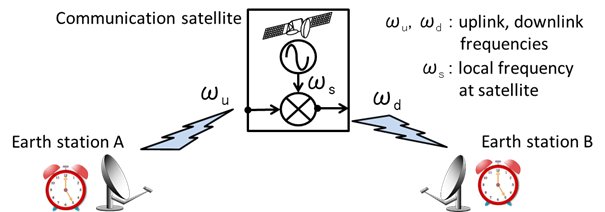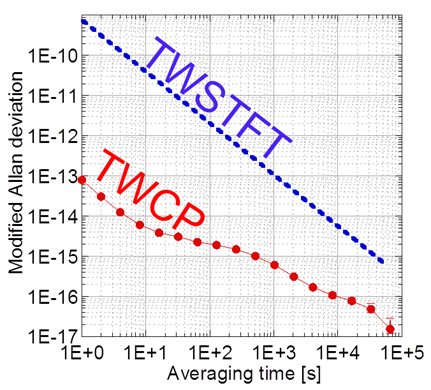TWCP
Carrier-Phase Two-Way Satellite Frequency Transfer
Two-way satellite time and frequency transfer (TWSTFT) is one of the time and frequency transfer methods which contributes to the generation of Coordinated Universal Time *1. A pair of earth stations transmits and receives CDMA (Code Division Multiple Access) signals through a geostationary communication satellite and is connected to a reference signal such as UTC(NICT). Since a code phase is used as a measurement scale in TWSTFT, the measurement precision is proportional to the code rate. Higher code rate enables higher measurement precision, but it needs wider frequency bandwidth. As a result, satellite link fee becomes higher. Thus the measurement precision remains same and it is not enough for comparison of advanced optical clocks.We have developed a carrier-phase two-way satellite frequency transfer (TWCP) method which utilizes a finer measurement scale based on a carrier phase *2. One of the issues in TWCP is how to cancel out the phase noise induced by an onboard oscillator in the frequency conversion at a communication satellite where an atomic clock is not available unlike a GPS satellite. We introduced a mathematical cancellation using 4 signals including a round-trip signal.
The measurement precision less than picosecond is achieved by TWCP, which is three digits better than that of TWSTFT. Additionally, we performed the world’s first optical-clock comparison through a satellite between Japan and Germany, with a baseline of 9,000 km *3, *4. The TWCP measurement is cost effective because it only requires one-tenth of the TWSTFT frequency bandwidth. We strive to further improve precision of this technique and continue to conduct research with the goal of dissemination to other institutions.
*1; D. Kirchner, Rev. of Radio Science, 27-44, 1999.
*2; M. Fujieda et al., IEEE TUFFC, 59, 12, 2625-2630, 2012.
*3; M. Fujieda et al., Metrologia, 51, 253-262, 2014.
*4; H. Hachisu et al., Optics Letters, 39, 14, 4072-4075, 2014.

